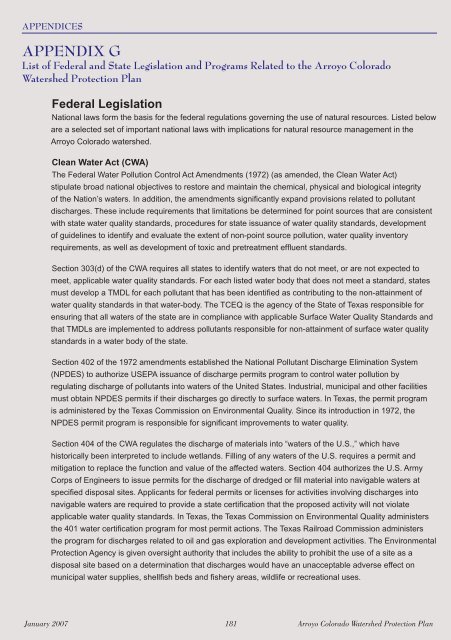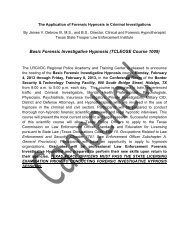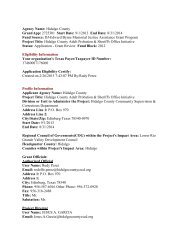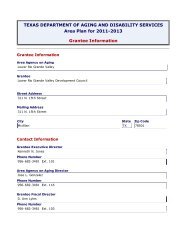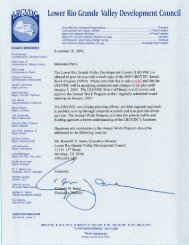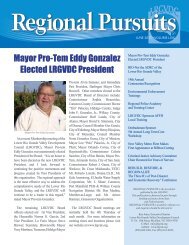Watershed Protection Plan - Lower Rio Grande Valley Development ...
Watershed Protection Plan - Lower Rio Grande Valley Development ...
Watershed Protection Plan - Lower Rio Grande Valley Development ...
Create successful ePaper yourself
Turn your PDF publications into a flip-book with our unique Google optimized e-Paper software.
APPENDICES<br />
APPENDIX G<br />
List of Federal and State Legislation and Programs Related to the Arroyo Colorado<br />
<strong>Watershed</strong> <strong>Protection</strong> <strong>Plan</strong><br />
Federal Legislation<br />
National laws form the basis for the federal regulations governing the use of natural resources. Listed below<br />
are a selected set of important national laws with implications for natural resource management in the<br />
Arroyo Colorado watershed.<br />
Clean Water Act (CWA)<br />
The Federal Water Pollution Control Act Amendments (1972) (as amended, the Clean Water Act)<br />
stipulate broad national objectives to restore and maintain the chemical, physical and biological integrity<br />
of the Nation’s waters. In addition, the amendments signifi cantly expand provisions related to pollutant<br />
discharges. These include requirements that limitations be determined for point sources that are consistent<br />
with state water quality standards, procedures for state issuance of water quality standards, development<br />
of guidelines to identify and evaluate the extent of non-point source pollution, water quality inventory<br />
requirements, as well as development of toxic and pretreatment effl uent standards.<br />
Section 303(d) of the CWA requires all states to identify waters that do not meet, or are not expected to<br />
meet, applicable water quality standards. For each listed water body that does not meet a standard, states<br />
must develop a TMDL for each pollutant that has been identifi ed as contributing to the non-attainment of<br />
water quality standards in that water-body. The TCEQ is the agency of the State of Texas responsible for<br />
ensuring that all waters of the state are in compliance with applicable Surface Water Quality Standards and<br />
that TMDLs are implemented to address pollutants responsible for non-attainment of surface water quality<br />
standards in a water body of the state.<br />
Section 402 of the 1972 amendments established the National Pollutant Discharge Elimination System<br />
(NPDES) to authorize USEPA issuance of discharge permits program to control water pollution by<br />
regulating discharge of pollutants into waters of the United States. Industrial, municipal and other facilities<br />
must obtain NPDES permits if their discharges go directly to surface waters. In Texas, the permit program<br />
is administered by the Texas Commission on Environmental Quality. Since its introduction in 1972, the<br />
NPDES permit program is responsible for signifi cant improvements to water quality.<br />
Section 404 of the CWA regulates the discharge of materials into “waters of the U.S.,” which have<br />
historically been interpreted to include wetlands. Filling of any waters of the U.S. requires a permit and<br />
mitigation to replace the function and value of the affected waters. Section 404 authorizes the U.S. Army<br />
Corps of Engineers to issue permits for the discharge of dredged or fi ll material into navigable waters at<br />
specifi ed disposal sites. Applicants for federal permits or licenses for activities involving discharges into<br />
navigable waters are required to provide a state certifi cation that the proposed activity will not violate<br />
applicable water quality standards. In Texas, the Texas Commission on Environmental Quality administers<br />
the 401 water certifi cation program for most permit actions. The Texas Railroad Commission administers<br />
the program for discharges related to oil and gas exploration and development activities. The Environmental<br />
<strong>Protection</strong> Agency is given oversight authority that includes the ability to prohibit the use of a site as a<br />
disposal site based on a determination that discharges would have an unacceptable adverse effect on<br />
municipal water supplies, shellfi sh beds and fi shery areas, wildlife or recreational uses.<br />
January 2007 181 Arroyo Colorado <strong>Watershed</strong> <strong>Protection</strong> <strong>Plan</strong>


